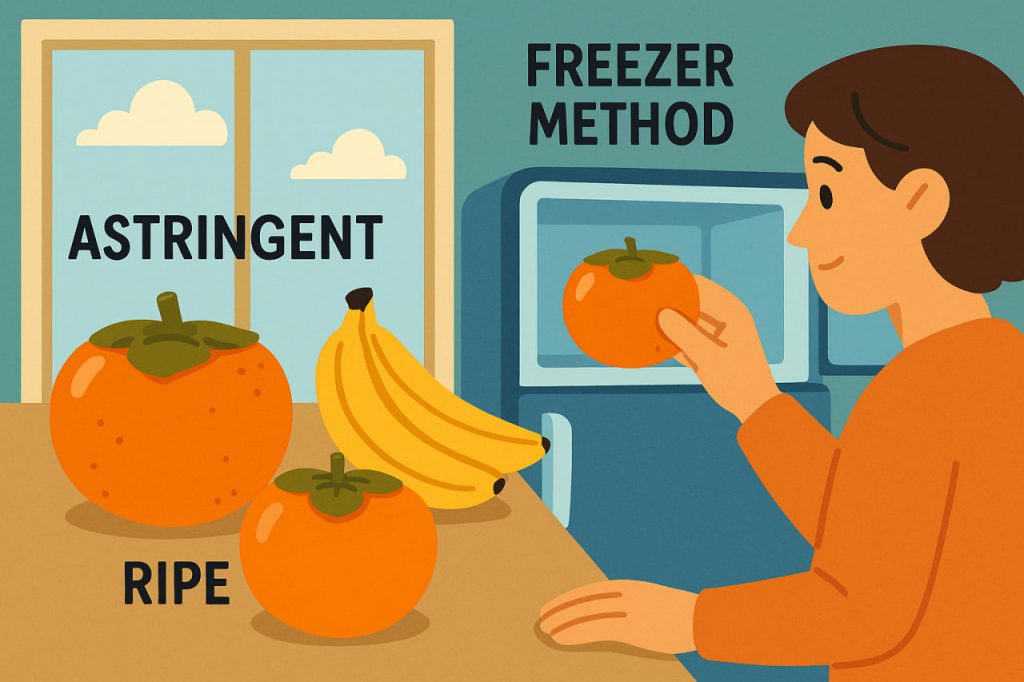Persimmons are one of autumn’s most delightful fruits, known for their bright orange color, honey-like flavor, and smooth texture when ripe. However, many people encounter a common issue: the astringent taste that can make an unripe persimmon unpleasantly dry and bitter in the mouth. This sensation occurs because of naturally occurring tannins, plant compounds that bind to proteins in saliva and create that “puckering” feeling. The good news is that there are several safe, natural ways to remove or reduce this astringency and enjoy persimmons at their sweetest and most flavorful stage.
Why Persimmons Taste Astringent
The astringency in certain types of persimmons, especially Hachiya and other “astringent varieties,” comes from soluble tannins. These compounds are beneficial antioxidants but are unpalatable when concentrated in unripe fruit. Non-astringent varieties, such as Fuyu, contain much lower tannin levels and can be eaten even when firm.
When the fruit ripens, enzymes and natural chemical changes convert soluble tannins into insoluble forms, eliminating the bitterness and leaving only the natural sweetness.
Natural Methods to Remove Astringency
- Ripen Naturally at Room Temperature
Simply leaving persimmons at room temperature for several days allows natural ripening enzymes to break down tannins. When the fruit becomes soft like a water balloon, it is fully ripe and safe to eat. Placing them near apples or bananas helps speed the process because these fruits emit ethylene gas, which accelerates ripening. - Use the Freezer Method
Freezing persimmons for 24–48 hours and then thawing them mimics natural overripe conditions. The cold breaks down cell walls, reducing astringency and enhancing sweetness. This is one of the fastest and most effective home methods. - Drying or Dehydrating
Drying persimmons under sunlight or in a dehydrator turns them into a sweet, chewy treat. The process removes moisture and helps convert tannins, giving a honey-like flavor similar to dried figs. - Cooking or Baking
Heat destroys tannins, so baking, steaming, or turning persimmons into jams and purees naturally removes the bitterness. Many recipes for persimmon pudding or bread call for overripe fruit for this reason.
Choosing the Right Variety
- Astringent types (Hachiya, Saijo, Tanenashi) — must be fully ripe before eating.
- Non-astringent types (Fuyu, Jiro, Sharon fruit) — can be eaten while still firm like an apple.
Knowing which kind you have is essential for avoiding that unpleasant dry-mouth sensation.
Nutritional Benefits
Persimmons are not only tasty but also extremely nutritious. They contain vitamin A, vitamin C, fiber, and powerful antioxidants like beta-carotene and catechins. Regular consumption supports heart health, boosts immunity, and promotes healthy digestion.
Culinary Uses
Once the astringency is gone, ripe persimmons can be enjoyed in many ways:
- Added to smoothies and yogurts for natural sweetness.
- Used in baking, such as muffins or tarts.
- Blended into sauces or jams.
- Sliced fresh over salads with nuts and cheese.
Interesting Facts
- Persimmons originated in East Asia over 2,000 years ago and are symbols of good fortune in Japan and Korea.
- The Sharon fruit, named after Israel’s Sharon Plain, is a specially bred non-astringent variety.
- Dried persimmons are called “hoshigaki” in Japan and are a traditional New Year delicacy.
- The tannins in unripe persimmons were historically used for leather tanning and ink making.
Glossary
- Tannins — natural compounds that cause bitterness and astringency in unripe fruit.
- Ethylene gas — a plant hormone that accelerates ripening.
- Astringency — the dry, puckering mouthfeel caused by tannins binding to saliva.
- Dehydration — removal of moisture from food to preserve and sweeten flavor.
- Hachiya — a heart-shaped persimmon variety that must be fully soft before eating.


